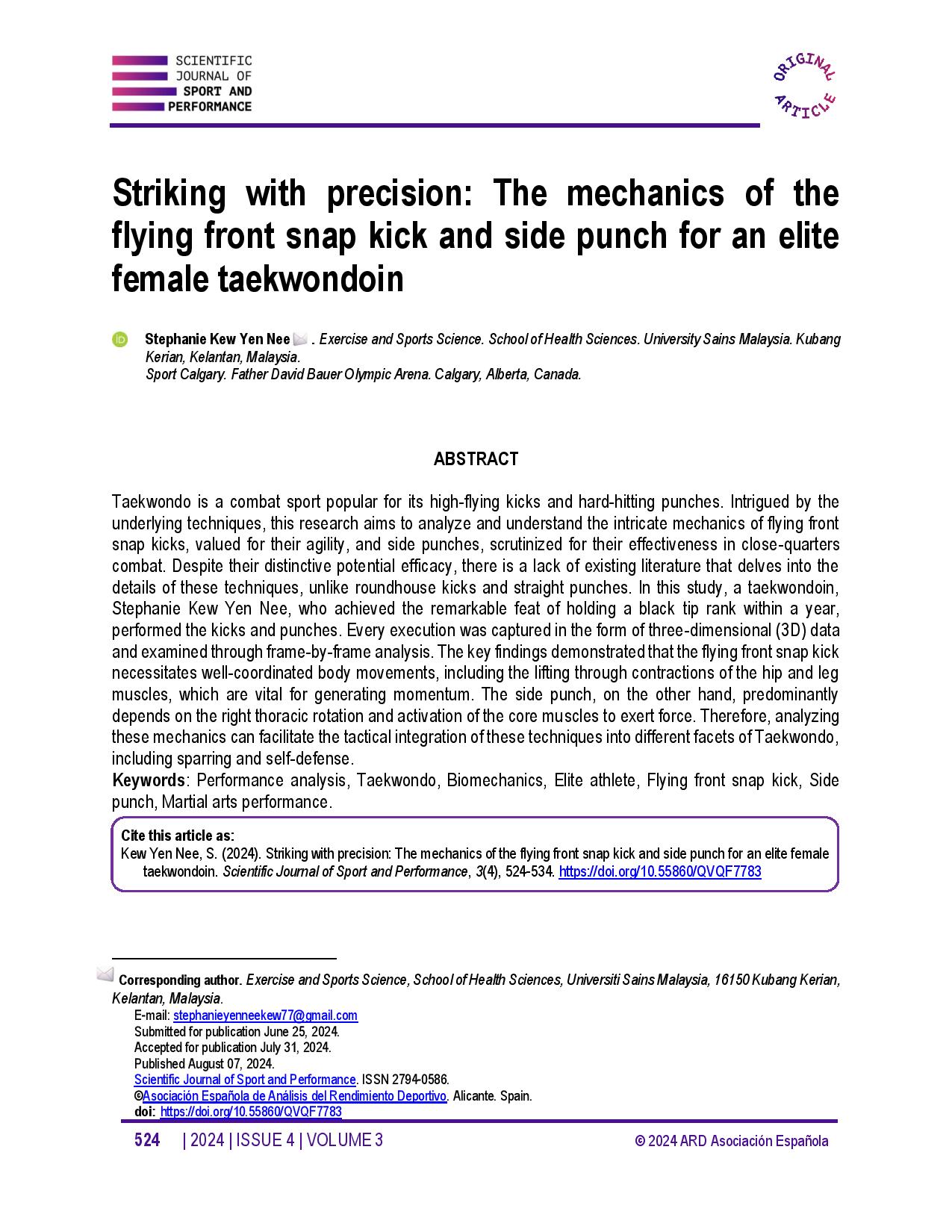Striking with precision The mechanics of the flying front snap kick and side punch for an elite female taekwondoin
Main Article Content
Abstract
Taekwondo is a combat sport popular for its high-flying kicks and hard-hitting punches. Intrigued by the underlying techniques, this research aims to analyze and understand the intricate mechanics of flying front snap kicks, valued for their agility, and side punches, scrutinized for their effectiveness in close-quarters combat. Despite their distinctive potential efficacy, there is a lack of existing literature that delves into the details of these techniques, unlike roundhouse kicks and straight punches. In this study, a taekwondoin, Stephanie Kew Yen Nee, who achieved the remarkable feat of holding a black tip rank within a year, performed the kicks and punches. Every execution was captured in the form of three-dimensional (3D) data and examined through frame-by-frame analysis. The key findings demonstrated that the flying front snap kick necessitates well-coordinated body movements, including the lifting through contractions of the hip and leg muscles, which are vital for generating momentum. The side punch, on the other hand, predominantly depends on the right thoracic rotation and activation of the core muscles to exert force. Therefore, analyzing these mechanics can facilitate the tactical integration of these techniques into different facets of Taekwondo, including sparring and self-defense.
Article Details

This work is licensed under a Creative Commons Attribution-NonCommercial-ShareAlike 4.0 International License.
Funding data
References
Almansoof, H. S., Nuhmani, S., & Muaidi, Q. (2023). Role of kinetic chain in sports performance and injury risk: A narrative review. Journal of Medicine and Life, 16(11), 1591-1596. https://doi.org/10.25122/jml-2023-0087 DOI: https://doi.org/10.25122/jml-2023-0087
Braun, V., & Clarke, V. (2012). Thematic analysis. In H. Cooper, P. M. Camic, D. L. Long, A. T. Panter, D. Rindskopf, & K. J. Sher (Eds.), APA handbook of research methods in psychology (Vol. 2, pp. 57-71). https://doi.org/10.1037/13620-004 DOI: https://doi.org/10.1037/13620-004
Clarke, V., & Braun, V. (2013). Teaching thematic analysis: Overcoming challenges and developing strategies for effective learning. The Psychologist, 26(2), 120-123. Retrieved from [Accessed 2024, August 02]: https://uwe-repository.worktribe.com/output/937596
Falco, C., Molina-García, J., Álvarez, O., & Estevan, I. (2013). Effects of target distance on select biomechanical parameters in taekwondo roundhouse kick. Sports Biomechanics, 12(4), 381-388. https://doi.org/10.1080/14763141.2013.776626 DOI: https://doi.org/10.1080/14763141.2013.776626
Gavagan, C. J., & Sayers, M. G. L. (2017). A biomechanical analysis of the roundhouse kicking technique of expert practitioners: A comparison between the martial arts disciplines of Muay Thai, Karate, and Taekwondo. PLoS ONE, 12(8). https://doi.org/10.1371/journal.pone.0182645 DOI: https://doi.org/10.1371/journal.pone.0182645
Ge, Y., Schinke, R., Dong, D., Lu, C., Si, G., & Oghene, O. (2016). Working with Chinese Olympic athletes in their national sport system: From the conceptual to a proposed research-practice integration. International Journal of Sport and Exercise Psychology, 17(1), 5-17. https://doi.org/10.1080/1612197X.2016.1164227 DOI: https://doi.org/10.1080/1612197X.2016.1164227
Henriksen, K., & Stambulova, N. (2023). The social environment of talent development in youth sport. Frontiers in Sports and Active Living. 5, 1127151. https://doi.org/10.3389/fspor.2023.1127151 DOI: https://doi.org/10.3389/fspor.2023.1127151
Henriksen, K., Stambulova, N., & Roessler, K. K. (2010). Holistic approach to athletic talent development environments: A successful sailing milieu. Psychology of Sport and Exercise, 11(3), 212-222. https://doi.org/10.1016/j.psychsport.2009.10.005 DOI: https://doi.org/10.1016/j.psychsport.2009.10.005
Ishac, K., & Eager, D. (2021). Evaluating martial arts punching kinematics using a vision and inertial sensing system. Sensors, 21(6), 1-25. https://doi.org/10.3390/s21061948 DOI: https://doi.org/10.3390/s21061948
Larkin, P., Barkell, J., & O'Connor, D. (2022). The practice environment - how coaches may promote athlete learning. Frontiers in Sports and Active Living, 4, 957086. https://doi.org/10.3389/fspor.2022.957086 DOI: https://doi.org/10.3389/fspor.2022.957086
Larsen, C. H., Alfermann, D., Henriksen, K., & Christensen, M. K. (2013). Successful talent development in soccer: The characteristics of the environment. Sport, Exercise, and Performance Psychology, 2(3), 190-206. https://doi.org/10.1037/a0031958 DOI: https://doi.org/10.1037/a0031958
Sant'Ana, J., Franchini, E., da Silva, V., & Diefenthaeler, F. (2017). Effect of fatigue on reaction time, response time, performance time, and kick impact in taekwondo roundhouse kick. Sports Biomechanics, 16(2), 201-209. https://doi.org/10.1080/14763141.2016.1217347 DOI: https://doi.org/10.1080/14763141.2016.1217347
Santos, J. F. da S., Dias, W. Vinicius., Herrera-Valenzuela, T., & Sander, M. M. F. (2020). Time-motion analysis and physiological responses to taekwondo combat in juvenile and adult athletes: A systematic review. Strength and Conditioning Journal, 42(2), 103-121. https://doi.org/10.1519/SSC.0000000000000517 DOI: https://doi.org/10.1519/SSC.0000000000000517
Seonwoo, Y. Y., & Jeong, Y. D. (2021). Exploring factors that influence taekwondo student athletes' intentions to pursue careers contributing to the sustainability of the korean taekwondo industry using the theory of planned behavior. Sustainability, 13(17). https://doi.org/10.3390/su13179893 DOI: https://doi.org/10.3390/su13179893
Thibordee, S., & Prasartwuth, O. (2014). Effectiveness of roundhouse kick in elite Taekwondo athletes. Journal of Electromyography and Kinesiology, 24(3), 353-358. https://doi.org/10.1016/j.jelekin.2014.02.002 DOI: https://doi.org/10.1016/j.jelekin.2014.02.002
Vagner, M., Cleather, D. J., Olah, V., Vacek, J., & Stastny, P. (2023). A systematic review of dynamic forces and kinematic indicators of front and roundhouse kicks across varied conditions and participant experience. Sports, 11(8). https://doi.org/10.3390/sports11080141 DOI: https://doi.org/10.3390/sports11080141
Wąsik, J., Borysiuk, Z., & Balkó, Š. (2017). Influence of acceleration of the fist on the effectiveness of the straight punch in taekwondo. Archives of Budo Science of Martial Arts and Extreme Sports, 13, 29-34. Retrieved from [Accessed 2024, August 02]: https://www.iat.uni-leipzig.de/datenbanken/iks/power/Record/4047099
Wąsik, J., & Nowak, K. (2015). Influence of different versions of the straight forward punch on the obtained force, energy and power-measurements of taekwon-do ITF athletes' performance. Archives of Budo Conference Proceedings, 2015, 149-154. Retrieved from [Accessed 2024, August 02]: https://sponet.de/Record/4038199
Wąsik, J., Ferreira da Silva Santos, J., & Franchini, E. (2013). Movement structure and kinetics of the traditional straight punch: Measurements in taekwon-do athletes. Journal of Martial Arts Anthropology, 13(1), 42-47. https://doi.org/10.14589/ido.13.1.6




